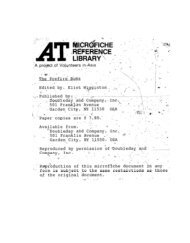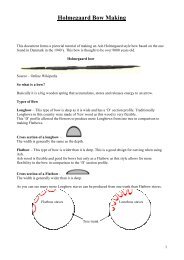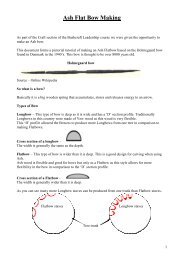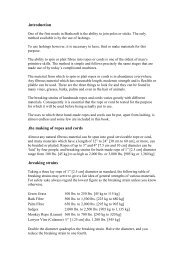Experiments on Knife Sharpening John D. Verhoeven ... - BushcraftUK
Experiments on Knife Sharpening John D. Verhoeven ... - BushcraftUK
Experiments on Knife Sharpening John D. Verhoeven ... - BushcraftUK
Create successful ePaper yourself
Turn your PDF publications into a flip-book with our unique Google optimized e-Paper software.
machine ground. The final 2β edge angle was ground here as will be described. Theseedges will be referred to as B edges, as labeled <strong>on</strong> the left of Fig. 6.Three different carb<strong>on</strong> steels were studied as listed in Table 2. Thesteels had been heat treated to the hardnesses listed in Table 2 bySteelstandard quench and tempered methods prior to grinding atBenchmade.<strong>Sharpening</strong> Machines In additi<strong>on</strong> to sharpening <strong>on</strong> standardhand st<strong>on</strong>es using a jig to maintain a c<strong>on</strong>stant edge angle, twodifferent machines were used to prepare sharpened edges. The operati<strong>on</strong> of thesemachines and the methods developed to set the grinding angles <strong>on</strong> each of them aredescribed in appendices 2 and 3.Razor Blade StandardsTable 2 Carb<strong>on</strong> steels studiedHardness1086 R c = 401086 R c = 6452100 R c = 60Damascus R c = 40Two types of razor blades were used to establish a standard that could be used tocompare blades produced in these experiments. The first blade was a Gillette doubleedged stainless steel blade produced in the early 1980s, when double edge blades werestill used in disposable razors. Figure 7 presents SEM micrographs of this blade in the 3orientati<strong>on</strong>s discussed for Fig. 1. Analysis of the edge width (EW) was d<strong>on</strong>e at 3 randomlocati<strong>on</strong>s al<strong>on</strong>g the edge at magnificati<strong>on</strong>s of 3000 to 10000x and values of EW varied <strong>on</strong>average between 0.35 and 0.45 micr<strong>on</strong>s (µm). The arrows <strong>on</strong> the edge view at the top ofFig. 7 illustrates this range. (Note: The SEM equipment places a line <strong>on</strong> the micrographs of a lengthcorresp<strong>on</strong>ding to the magnificati<strong>on</strong>. For example, the vertical text <strong>on</strong> the Edge View shows the line to the left ofx3000. Vertically above x3000 you see 10 µm, which specifies that the vertical line is 10 micr<strong>on</strong>s l<strong>on</strong>g (micr<strong>on</strong> = µm).The label 10 micr<strong>on</strong>s to the left of x3000 was added there by the author, but in future micrographs this additi<strong>on</strong>al labelwill be omitted since it can be found vertically above the x value.) The two face views have a straight linesuperimposed just to the right of the sharpened edge to allow a measure of the edgestraightness. The edge angle, 2β, was measured with the laser device of App. 1 to be 17 o ,and the 2α face angle was found to be 12 o . These values agree well with those reportedfor Wilkins<strong>on</strong> razor blades in a 1978 paper [4]. Although that paper reports thinner EW6








